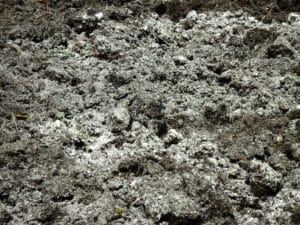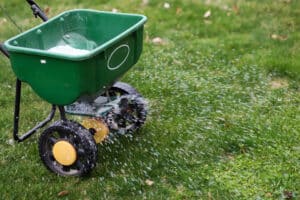You’ve probably seen lawns that have patchy, bare spots of thinning grass, but if you’re dreaming of a carpet of green, there are several surefire ways to whip a lawn into shape. You can patch any balding sections, mow and water properly to maintain the lawn, and aerate and dethatch to see serious improvements.
When it comes to maintaining a healthy, flourishing lawn, we recommend hiring a professional lawn care company. For example, industry leader TruGreen offers overseeding in select areas, as well as the fertilization, aeration, and weed control you need to get your lawn thriving.
Find Lawn Help
- See our list of top lawn care companies based on in-depth research.
- Select the company that best meets your needs.
- Get a free, no-obligation quote for your home.
Get a Quote From Lawn Professionals Near You
Compare quotes from local pros

Lime Soil Amendment

Lawn Fertilization
How To Fill in Bare or Patchy Spots
Patching your lawn may seem like a big undertaking, but you can get it done in a few simple steps.
First, choose whether you want to use seed or sod. In either case, make sure to select a grass type that will thrive in your region and the specific conditions of your yard. If you have large trees that cast a lot of shade, you’ll want to purchase a shade-resistant grass that doesn’t need too much sunlight.
How To Patch a Lawn With Seed
Reseeding is a simple and effective way to fill in bare spots and improve overall lawn density. Follow these steps to ensure your new grass takes root and thrives.
- Dig a border using a sharp spade and get rid of any debris or weeds in the delineated area. Rake up the soil, then leave it level and smooth.
- Distribute the seed with a spreader, using the appropriate amount for the designated space. Spread the seed so that it covers the surface, but don’t let the seeds overlap with one another. For uniformity, spread half the seed in an east/west pattern and half the seed north/south.
- Rake over the seed for even distribution. Then, cover the top with about 1/2 inch of straw or topsoil to keep the seeds moist and protect them from birds.
- For the first week or two, you’ll need to water your lawn daily or twice a day to make sure the soil is moist, but not soggy. Once the seedlings begin to emerge, you can dial back the irrigation to two deep, infrequent waterings totaling 1–1.5 inches per week.
- Don’t mow until the grass reaches a height of about 3–3.5 inches. Then, be sure to cut no more than the top third of the grass blade to encourage drought resistance and deep root growth, and discourage weeds.
- It may take up to eight weeks, depending on the grass type you selected, for the new grass to blend in fully with the rest of your lawn. If you need to mow the rest of your lawn before then, be careful to avoid the newly seeded grass.
How To Patch a Lawn With Sod
Patching with sod yields instant gratification because it introduces new, grown, lush grass. It’s particularly convenient if you have multiple bare spots and don’t want to overseed again and again. Keep in mind, however, that sod costs significantly more than seed.
- Start by cutting a patch of the sod from a roll, slightly larger than the bare spot you wish to cover so that it extends past the borders about 2–3 inches on all sides. Make sure the sod stays moist as you prepare it.
- Dig into the area you want to cover about 1–1.5 inches down so that the new sod will be level with the rest of the lawn, removing all the brown grass, including the roots. Use a rake to loosen the soil and even out the area.
- Put the patch of sod over the bare spot you want to cover. Press it firmly into the soil, and make sure its edges are snug against the lawn around it. You can walk across it to make sure it settles in well. Water the sod daily for two weeks, unless the forecast shows heavy rain—if it does, adjust the irrigation accordingly.
Simple Ways To Improve Your Lawn
If your issue isn’t bare or balding patches but simply grass that’s taken on a gray shade or doesn’t look as vibrant as it once did, consider following these recommendations.
Perform a Soil Test
If your grass appears stressed, you may benefit from a soil test. Your soil could have a chronic issue, like an incorrect soil pH that’s left it too acidic or too alkaline, or missing nutrients like nitrogen. Send a soil sample to your local cooperative university extension to have your soil assessed for any issues and to learn the recommended amendments to rectify them.
Use Organic Fertilizer
It may be tempting to use quick-release, synthetic fertilizers that yield fast grass growth. But over time, these types of fertilizers can leach your lawn of nutrients and harm the environment. Organic fertilizers, composed of matter like bone and feather meal, manure, liquid kelp, and guano, may be more expensive and take longer to show results, but they ultimately create greener, healthier lawns.
Aerate
If your lawn experiences a lot of foot traffic, your soil may become compacted, meaning that it’s packed too densely and the grass roots can’t access the water, air, and nutrients they need. You can improve your turf’s health by aerating, using a machine that punctures many tiny holes in your lawn to assist with soil drainage, air circulation, and nutrient absorption.
You can rent or purchase a core, slice, or spike aerator. Core aerators are popular. They pull “cores,” or plugs, of soil out, which you can then leave to decompose on top of the grass. This alleviates compaction and introduces beneficial organic matter back into the soil.
Water Deeply and Infrequently
Light daily watering can lead to shallow roots, making your lawn more susceptible to weeds, pests, and diseases. Watering deeply but infrequently, giving your grass 1–1.5 inches of water a week spread out over one to two waterings, lets your grass grow strong and deep into the soil.
Cut Your Grass Correctly
Different grasses thrive at different heights. For healthy, strong grass, research the best height for your grass type. Always make sure your lawn mower blades are sharp, or else you risk shredding your grass instead of cutting it cleanly.
Dethatch
Thatch is the layer of decomposing organic material that accumulates between the soil and grass blades. A small layer of thatch protects the grassroots, but if the thatch layer gets thick enough to create a dense mat—over 1/2 inch thick—it can choke your grass, blocking the flow of air, water, and nutrients. Use a dethatching rake to break up the excessive thatch, leaving a thin layer for insulation.
Top Recommended Lawn Care Provider
Lawn care provider TruGreen offers five different annual plans and a variety of à la carte services so homeowners can customize their care for their lawn’s unique needs. Highly trained lawn care specialists can amend your soil, fertilize, aerate, and more to ensure that your lawn grows healthy, thick, and green. Read more about what makes TruGreen our top provider in our in-depth review.
FAQs About Repairing and Improving Your Lawn
How do you restore an unhealthy lawn?
You can fill in bare spots on a lawn with seed or sod. To restore your entire lawn, follow these tips:
- Perform a soil test.
- Use organic fertilizer.
- Aerate.
- Water deeply and infrequently.
- Cut your grass correctly.
- Dethatch.
Can you revive a dying lawn?
If your grass is dead, you will have to start over with new grass. If your lawn is brown but not completely dead, you can revive it with proper care. Water correctly, give it the nutrients it needs, don’t mow aggressively, and wait for cooler temperatures for northern lawns and warmer temperatures for southern lawns.
How do I fix my lawn full of weeds?
You can fix a lawn that’s full of weeds by following these steps:
- Identify the weeds you have.
- Select a proper herbicide and apply the treatment.
- Mow, rake, and till.
- Dethatch and aerate.
- Test and amend the soil.
- Lay down seed or sod.
- Water and maintain your lawn.
Our Rating Methodology
We back up our lawn recommendations with a detailed rating methodology that we use to objectively score each provider. We review lawn care plans and packages, navigate the provider website and speak with customer service representatives, request quotes, and analyze customer reviews for each provider. We then score the provider against our review standards for plan options, additional benefits and customizability, availability, trustworthiness, and customer service to arrive at a final score out of 100.





